Pet Fooled- Truth About Pet Food
Kohl Harrington, Director
 Pet food advocate and director of the movie "Pet Fooled," Kohl Harrington, believed you were being lied to and manipulated by the major pet food manufacturers - all in the name of economics. Kohl shares the information he collected while producing his movie, including documentation that you were being deceived into slowly killing your pets; and even paid hush money by pet food makers. You'll want to hear this before you shop for pet food again! Surprisingly, all of the pet food you see on the shelves in stores like Petco and PetSmart and even the grocery store, are mostly made by the same manufacturers.
Pet food advocate and director of the movie "Pet Fooled," Kohl Harrington, believed you were being lied to and manipulated by the major pet food manufacturers - all in the name of economics. Kohl shares the information he collected while producing his movie, including documentation that you were being deceived into slowly killing your pets; and even paid hush money by pet food makers. You'll want to hear this before you shop for pet food again! Surprisingly, all of the pet food you see on the shelves in stores like Petco and PetSmart and even the grocery store, are mostly made by the same manufacturers.
Kohl Harrington felt the lobbying association for pet food was very well spoken and very well worded. In his opinion, there was an effort to 'not' talk up front about what is actually appropriate for a dog and a cat to eat.
So what is appropriate for our dogs and cats to eat? When Kohl started the film, he says there were two sides. One side, being the industry, would say corn and wheat is fine. Another side would say feed what is species appropriate. This led Kohl to try and figure out exactly what is species appropriate. If corn and wheat are not appropriate, what is? There was a lot of confusion out there around this because industries were making a lot of money off of products that were primarily filled with corn and wheat and other questionable ingredients, because it was a very inexpensive way to make a food.
As companies made foods with these ingredients, they went above and beyond to have well written documentation to support every ingredient that went into their food. So they told you corn was a nutritious form of protein. But what they didn't say if it was species appropriate or not, nor what was the digestibility of the corn compared to a fresh food diet.
Also, when you see pet food packaging in the store, for example like Beneful, they have placed beautiful, fresh-looking food on the label. However, when you open it, it doesn't look like that. So what is it? Kohl tells you to turn the bag over and look at the list of ingredients. By the time Kohl's film came out, there were new Beneful products with meat listed as the first ingredient. However, Kohl states that often times it is a marketing ploy to say, look, there is meat first on the label. But what comes after that?
 Kohl states his film was advocating the approach to feeding. The most shocking thing Kohl learned while making his film is that dry dog and cat food are not species appropriate. They are a convenience for people, not for the animals. The industry is not talking about optimal nutrition; it's just a convenient way to feed. You can also feed your dog a vegan diet, but that doesn't make it appropriate just because it exists.
Kohl states his film was advocating the approach to feeding. The most shocking thing Kohl learned while making his film is that dry dog and cat food are not species appropriate. They are a convenience for people, not for the animals. The industry is not talking about optimal nutrition; it's just a convenient way to feed. You can also feed your dog a vegan diet, but that doesn't make it appropriate just because it exists.
You need to dial back your approach to feeding. You need to mimic, if you're feeding a commercial pet food, what is actually appropriate for the species to eat to begin with. But the industry is not built on that. They're built on what they want to offer and that's what's confusing for the consumer. We trust everyone and we think if it is available, it must be good. But as many recalls have shown, that's not necessarily the case.
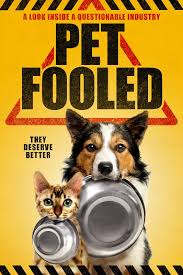 Midway through the film, Kohl started hearing about animals that were getting sick and dying from eating chicken jerky. Since the pet food industry claims to be one of the most highly regulated industries, Kohl was surprised to learn that there was not a database that people had access to that showed what animals got sick and where they were located. Pet owners would have to call the companies and then would be told to call the U.S. Food & Drug Administration (FDA) and make a report. Kohl luckily came into contact with a citizen in Ohio who had a database full of all of the information from people who made the complaints to her, because there was no government agency doing this. She had access to what dogs got sick, how many dogs in the family got sick, what treats they were, what lot number they were, did the animal just get sick and then get better or did the animal die? Through her, Kohl was able to speak directly to many people who had this issue. While some animals only got sick, there were others that unfortunately died after eating the chicken treats.
Midway through the film, Kohl started hearing about animals that were getting sick and dying from eating chicken jerky. Since the pet food industry claims to be one of the most highly regulated industries, Kohl was surprised to learn that there was not a database that people had access to that showed what animals got sick and where they were located. Pet owners would have to call the companies and then would be told to call the U.S. Food & Drug Administration (FDA) and make a report. Kohl luckily came into contact with a citizen in Ohio who had a database full of all of the information from people who made the complaints to her, because there was no government agency doing this. She had access to what dogs got sick, how many dogs in the family got sick, what treats they were, what lot number they were, did the animal just get sick and then get better or did the animal die? Through her, Kohl was able to speak directly to many people who had this issue. While some animals only got sick, there were others that unfortunately died after eating the chicken treats.
Kohl did speak with the FDA, as shown in the film, who admitted that they knew there was a problem, but they couldn't find a "smoking gun." Kohl's question then was since they knew there was a problem with the product, why did they still allow the product to be sold? Because the FDA couldn't find a "smoking gun," the product remained on the shelf for years. Pet owners then had to ban together on Facebook to share information and get it out there about the products and what was going on. At the same time, companies were trying to get pet owners to sign non-disclosure agreements so they couldn't sue and offered them $100, sort of "hush" money not to talk.
When a human life is lost, that life might be valued at around 5 or 6 million dollars. But when a pet's life is lost, they are still viewed as property. Because it is a big industry, it is easier for these big companies to pay off small lawsuits to make them go away than it is to actually change things.
The thing Kohl wants people to take away from his film is the approach to feeding. Feed what is species appropriate because you do have companies and organizations out there that want to say by-products are fine, but that is not the issue. The issue is the quality. There is a wide range of quality; from quality A to quality F, but this is not what is being told to the consumer. You can make your pet's food yourself, if you want to do the proper research, but if you're buying a commercial pet food, these issues are always going to exist no matter what the food is or the feeding style. You need to know the quality of the ingredients in the product and where the ingredients came from.
Visit Website
What The Pet Food Manufacturers Want You To Know
Mary Emma Young, Pet Food Institute (PFI)
 The pet food industry is worth 29 BILLION dollars a year. With so much at stake, they've formed a lobbying group called Pet Food Institute. PFI's Communications Director, Mary Emma Young joins us to tell you want they want you to know about pet food
The pet food industry is worth 29 BILLION dollars a year. With so much at stake, they've formed a lobbying group called Pet Food Institute. PFI's Communications Director, Mary Emma Young joins us to tell you want they want you to know about pet food
Mary Emma Young is the Head of Communication for the Pet Food Institute (PFI). The PFI is the National Trade Association for U.S. pet food makers. They are based in Washington D.C., with pet food and treat makers comprising their member companies. They make about 98-percent of all of the pet food and treat products for dogs and cats that you will see on the store shelves.
According to Mary Emma, as the trade association, they advocate on behalf of the industry, whether that is working with their regulatory bodies, such as the U.S. Food and Drug Administration or communications outreach, as she does. PFI is funded through their member companies. Those companies provide the dues for PFI as part of their ongoing outreach and activities.
Mary Emma tells us that people are surprised to hear that pet food is one of the most regulated food products in the U.S. One of the big ways in which pet food is regulated is under the U.S. Food and Drug Administration. There was a sweeping food safety law signed into effect in 2011, called the Food Safety Modernization Act (FSMA). This included some rules that codified many of the ongoing industry practices, so pet food and treat makers are currently entering enforcement and compliance under FSMA, which is based on company size. Smaller companies have more time to prepare for obligations under FSMA. Recently, what PFI has been doing, is reaching out to some of those companies to make sure they fully understand their requirements under FSMA.
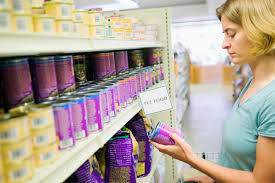 When you look at all of the pet foods available, it is hard to make the selection for your pet. However, the same manufacturers make most of the food. Mary Emma says you will see a number of co-manufacturers out there who will produce foods for other brands in the industry.
When you look at all of the pet foods available, it is hard to make the selection for your pet. However, the same manufacturers make most of the food. Mary Emma says you will see a number of co-manufacturers out there who will produce foods for other brands in the industry.
In 2007 there was a big pet food recall due to melamine in the food. It turned out that all of the many different brands of pet food being recalled were sourced from the same factory. Mary Emma says that was a tragic incident, which was the result of an intentional criminal adulteration of ingredients by an organization. This organization was trying to increase the protein levels in pet food by using melamine instead of natural resources for economic gain. This was something that the industry had never seen before.
So how can we prevent this type of thing from happening again? Mary Emma tells us that prior to FSMA, companies have had a number of practices in place. But since 2011, with FSMA signed into law, they have seen three critical steps that each company must now comply with. First is establishing what they call good manufacturing practices. This includes requirements for employee hygiene, facility design, equipment upkeep and maintenance. Next is establishing preventive controls. That means looking for what the potential hazards are across the manufacturing process, and after those hazards are identified, preemptively taking steps to mitigate them in advance. Lastly, each company has to have a food safety plan. These are written steps that they must take to ensure product safety from sourcing ingredients to the steps need to carry out a product recall.
It seems like there are more pet food recalls than ever. Could this because there is a lot of bad food out there or because we are more vigilant? There was even a recall with pentobarbital in pet foods, which is an agent used to euthanize animals. This indicated that the meat used for pet food had euthanized animals in it. When you looked at the packaging, all the meats and vegetables look so fresh, you would never expect there to be dead animals in it.
Mary Emma explains that before an ingredient can be used in pet food, it has to be recognized in four different ways, whether it is at the federal level and the state level. You can find out more about those four specific steps at the Pet Food Institute website.
So what should our animals be eating? Marry Emma suggests that you want to pick what's best for your pet. You should also look for a few different components on the label. First is to ensure that that recipe is marked as complete and balanced. This means that it is including the right nutrients levels at the right amount. That level can be tested through the company itself, but pet food products are also registered in each state and that is normally something that will be examined at the state registration as well.
When picking out pet food, the first thing most people look for is meat on the list of ingredients. However, many foods list by-products, corn and meal as the first ingredients. So what is an appropriate food for our animals? Mary Emma tells us that ingredients tend to be a little trendy, just like in human foods. Sometimes an ingredient can get a bad rap that it might not deserve. So, a first ingredient might be beef or rice, or even meal. She states what's more important, in her view, is that the nutrient profile is there, so your pet is getting the protein, fiber and the fat that they need. She states that different ingredients can deliver this, so it's whatever makes the pet parent feel good.
So how does Mary Emma feel about a raw diet? She tells us at the PFI that they are neutral on raw food and if folks want to feed a raw diet to their pet, she thinks this is fine. However, there are two items she likes people to be aware of. First, ensuring that it is a nutritionally complete meal and that it has all of the vitamins and minerals that other diets may provide. Her other advice is to be aware of the safety and handling concerns of salmonella and E. Coli exposure from raw meat, more so for the humans handing the food than the animal that eats it.
 As Mary Emma mentioned, the pet food industry is one of the most regulated industries. However, when thinking about the prime meats that you want to eat, you think about the best cuts of meat. But in pet food, it seems like the meat contains just about everything part of an animal, which is less desirable.
As Mary Emma mentioned, the pet food industry is one of the most regulated industries. However, when thinking about the prime meats that you want to eat, you think about the best cuts of meat. But in pet food, it seems like the meat contains just about everything part of an animal, which is less desirable.
First, Mary Emma explains what a by-product is, which is typically what's used for a rendered meal. A by-product is parts of the animal that we as Americans do not eat. However, in other countries, these animal parts might be considered a delicacy. The fact is that by using these by-products, it's a great way to prevent food waste, because it is still nutrient dense edible material. In the wild, that is what a wild dog would go for first, which are the parts of dead animals that we would turn our nose up to.
Mary Emma claims she is always a little bit shocked when she hears someone say that the manufacturers' interests are not so much in our pet's health but in the bottom line of making money. PFI has done some recent discussions with their member companies and they have activities across the board supporting pets, because pets are such a part of the culture at those companies. In fact, the pet ownership rates at their member companies are greater than the national average. More people at their member companies have more pets than what you will find on the streets. They are also doing initiatives across the field in supporting pets, whether it is supporting initiatives such as building dog parks, or pet friendly policies at the office, to donating tens of millions of pounds of food to emergency relief efforts or shelters. They are doing a lot of steps demonstrating that pets are a big part of the culture at these companies.
So how can you believe and trust company like PFI, which is essentially funded by all of the major pet food companies? Mary Emma tells us that their efforts are on raising the standard across the industry and executing safety and pet nutrition.
Visit Website
Will Your Dog's Chew Bone Injure Her Teeth? - Dr. Debbie
 Even veterinarians can make bad choices when it comes to their pet's health. I learned this when I discovered my dog, Nikki, had a broken tooth. The cause was a chew item I thought was a safe option for her to gnaw on. But I was wrong - no chew item is risk free. Sadly my Nikki had to crack three teeth for me to learn that lesson.
Even veterinarians can make bad choices when it comes to their pet's health. I learned this when I discovered my dog, Nikki, had a broken tooth. The cause was a chew item I thought was a safe option for her to gnaw on. But I was wrong - no chew item is risk free. Sadly my Nikki had to crack three teeth for me to learn that lesson.
Oh yes, it was three broken teeth! But more on that later...
Considering Chew Options
What chew options are there? As the owner of a large powerful chewer I considered the possibilities for my dog. She has a sensitive stomach and cannot tolerate edible bones or preserved rawhide products. Thank goodness, because feeding my dog pig snouts or pizzles just makes me want to gag. I'm not a fan of real bones - too many patients with broken teeth, gastrointestinal blockages and even one with a bone shard migrating through the side of a dog's throat. Soft plastic toys don't survive the first two minutes with her, and plush toys quickly lose eyes, limbs and squeakers with her near surgical precision. So I chose to offer synthetic Nylabone style bones to deal with her chewing drive. Nikki loves the flavors and happily chews away for long periods of time. When the bone looks damaged, I throw it away. It seemed like the perfect solution for a vigorous chewer.
Discovering Her Broken Tooth
While brushing Nikki's teeth, I noted a fracture of her upper fourth premolar tooth. This is the largest cheek tooth on a dog or cat's upper jaw, which serves to chew and grind food. The outer layer of the tooth was sheared off, just like a shelf of ice cracking off an iceberg. This type of fracture is common from dogs chewing on an object harder than tooth enamel. Common culprits for this type of tooth damage include antler chews, Nylabones, real bones or ice.
What to Do With Broken Teeth?
Not all tooth fractures are created equal. An uncomplicated tooth fracture is one in which only the enamel is broken. The tooth is vulnerable to further injury but is not immediately causing the pet pain. A complicated fracture is one in which the break extends beyond the enamel into the pulp chamber.
The pulp of a tooth is the inner layer where the nerve and blood supply runs. Exposure of the pulp not only causes pain, but serves as direct pathway for oral bacteria to cause a tooth abscess or spread through the bloodstream.
How to Treat a Tooth Fracture?
A complicated tooth fracture requires either a root canal or surgical extraction. Leaving a complicated tooth fracture untreated is NOT an option. These teeth hurt and shouldn't be ignored. Pets won't whine or cry out in pain with broken teeth, but rather suffer in silence. But after a diseased tooth is addressed, owners commonly note their pet's overall activity and attitude improve.
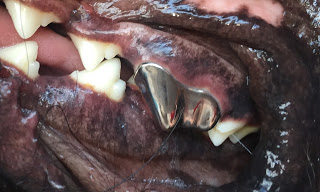 The preferred treatment for a complicated tooth fractures is a root canal. During a root canal the contents of the pulp are removed, filled in, and the tooth is sealed. After the root canal therapy the tooth is still functional for normal chewing activities.
The preferred treatment for a complicated tooth fractures is a root canal. During a root canal the contents of the pulp are removed, filled in, and the tooth is sealed. After the root canal therapy the tooth is still functional for normal chewing activities.
If a root canal cannot be pursued, then the tooth should be surgically extracted. This removes the source of pain and potential infection. However, surgical removal of broken teeth may affect the pet's ability to chew on that side in the future.
Uncomplicated tooth fractures aren't treated as above, but rather may need outward support of the area with bonding restoration.
My Dog's Dentist Visit
Dental cleanings and extractions are a daily service at most veterinary practices, but root canals and tooth restorations aren't commonly available at general practices. I knew I could pull Nikki's tooth, but to save this tooth in my young dog, I'd need to see a veterinary dental specialist.
Nikki and I arrived at Arizona Veterinary Dental Specialists where she was evaluated by Dr. Chris Visor who determined that she had an uncomplicated fracture of her premolar and small uncomplicated breaks on two molars.
Her premolar fracture was limited to the enamel, luckily sparing pulp damage, which means she wasn't in pain. But the damaged tooth would be at risk for further injury, so she was fitted for a restoration with a metallic crown (porcelain isn't durable in pets so it's not commonly used). The two other broken teeth had minor damage, so the rough edges were drilled smooth and the tooth surface bonded.
Lesson Learned
After her crown placement, Nikki can't chew on hard chew bones like before. If she did, it could risk damage to her crown as well as her other teeth. Veterinary dentists warn dog owners to try this test of your dog's chew item - if you whack your knee with your dog's chew item and it hurts you, it'll likely break her teeth.
Now I can only imagine scores of dog owners going to their doctors with knee pain….
Take Away Tips: Can You Detect Your Pet's Broken Tooth? Most broken teeth are detected during a physical exam by your veterinarian, but some observant pet owners may discover clues to their pet's broken tooth.
1. No complaining. Don't expect your pet to cry or whine. People complain loudly when a tooth hurts, but pets just don't verbalize dental pain.
2. Uneven tartar accumulation. Due to tooth pain, the pet chews on one side more, the "good side." Tartar builds up more on the "bad side."
3. Dark spot on tooth. Enamel is evenly white, but darker or grey spots could indicate exposed pulp or dentin at the site of a fracture.
4. Draining wound present below the eye. A broken upper premolar or molar with an infected root can cause a draining wound under the eye.
If you notice any of these signs, get your dog to a veterinarian right away.
Featured veterinarian known as "Dr. Debbie" on national pet radio program, Animal Radio. Ebook author of "Yorkshire Terriers: How to Be Your Dog's Best Friend"; "Pugs: How to Be Your Dog's Best Friend"; "Mini Schnauzers: How to Be Your Dog's Best Friend"; and "Shih Tzu: How to Be Your Dog's Best Friend." Dr. Debbie's books.
Visit Website
Animal Radio News - Lori Brooks
 Employer Offered "Pawternity" Leave
Employer Offered "Pawternity" Leave
Harper-Collins Publishers in India offered their employees "pawternity leave" when they adopted a new pet, by giving workers up to five working days of paid leave to settle in with their new animal friend. The publisher said it wanted to encourage responsible adoption of animals as well as make life easier for their staff that choose to open their homes to furry friends. The company also hoped to improve the work-life balance of employees and the pawternity leave was part of their being mindful about the family needs of employees. More and more people are opting to get pets nowadays, so pet-friendly companies could get a lot of appreciation from job seekers, particularly the younger generation, as research has shown that millennials are more likely to choose to have pets than children. There has been a growing trend in giving employees time off for their pets, according to a report from Business Insider. Mars Petcare, BitSol Solutions and BrewDog also offer pawternity leave, while Kimpton Hotels & Restaurants in San Francisco, Mars Inc., Maxwell Health in Boston and Trupanion let their staff take some time off to grieve a pet that just passed away.
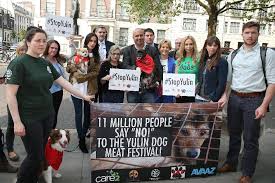 Dog Meat Banned at Festival
Dog Meat Banned at Festival
After a lot of activism and bad publicity, dog meat sales were banned at China's annual Yulin Festival. The local government rolled out a ban affecting restaurants, street vendors and dog meat traders. Violators faced fines of $15,000. The dog meat trade in China is also responsible for the theft of pets in the country. Health concerns abound with regard to dog meat consumption, as China has the second-highest number of reported rabies cases in the world, according to the World Health Organization.
Victims Scammed After Buying Dogs Online
Police in the town of Winkler, Manitoba, Canada, asked people to be extra vigilant when buying anything online after three people were scammed out of hundreds of dollars after buying dogs that they never received. The victims had all responded to online classified ads listing dogs for sale. This unfortunately happens frequently in the United States as well. The way it worked was after conversing with the seller, the buyers were forced into paying extra fees for services like kenneling, shipping, and insurance or excise taxes. Once the buyers started asking questions about the fees, the dog sellers forced them into paying by threatening to file lawsuits against them for abandoning the deal or by telling them they could be charged with animal cruelty for walking away from the sale. In the end, none of the three victims received their dogs. An easy way to avoid a scam is going to a local rescue shelter or by contacting any of the thousands of pet rescues, even breed specific rescues that usually only take purebred dogs, all of which have many dogs you can adopt.
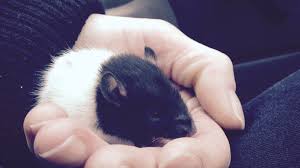 Pet Rat Saved After Heroin Overdose
Pet Rat Saved After Heroin Overdose
Volunteers at an overdose prevention site in Vancouver, Canada, saved the life of a pet rat named Snuggles after the little rodent overdosed on heroin it had eaten off a table. The former owner brought Snuggles in near death. The volunteers weren't sure what to do, so they gave it some Narcan drops on the nose. Narcan is given by injection or by nasal spray, but because Snuggles was so tiny, they didn't want to risk anything by giving an injection. Snuggles made a full recovery and the woman who took the rat to the center asked one of the volunteers to care for Snuggles while she went through addiction treatment.
Parents Approve of Animal Videos
Whether on YouTube, television, Facebook or Instagram, video content featuring pets and animals continues to keep kids and parents laughing and learning. A study found that nearly half of parents let their children watch animal-based TV shows and videos because critters, creatures and furry friends make their kids laugh and smile. Fifty-nine percent of parents let their kids watch content featuring animals because it educates them about nature, 41-percent because it informs about emotions and 21-percent because it tends to be about safer topics. The study also found that 82-percent of parents and kids take photos or videos of their pets at least once a week. Not surprisingly, dogs and cats were found to be kids' preferred animals when given the choice to have any pet. Across all six countries, dogs, cats and fish were found to be the most common family pets and 27-percent of kids and parents chose to name their pets after a cartoon or film character. The study also revealed that the top five favorite animal characters of all time were some of the most iconic, which include Scooby-Doo, Tom and Jerry, Garfield, Mickey and Minnie Mouse and Bugs Bunny.
 Free Cat Yoga Classes
Free Cat Yoga Classes
For cat lovers and exercise enthusiasts, free yoga classes filled with feline friends sounded like a pretty good deal. But these classes were offered with a larger purpose in mind, as the cats needed homes. The P.A.W.S. Animal Adoption Center in Camden, Maine, was offering free monthly cat yoga classes as a way to introduce potential new pet owners to some kitties in need. And there was a happy ending for the cats too, since all of the cats that participated were adopted.
 Listen to the entire Podcast of this show (#1171)
Listen to the entire Podcast of this show (#1171)





